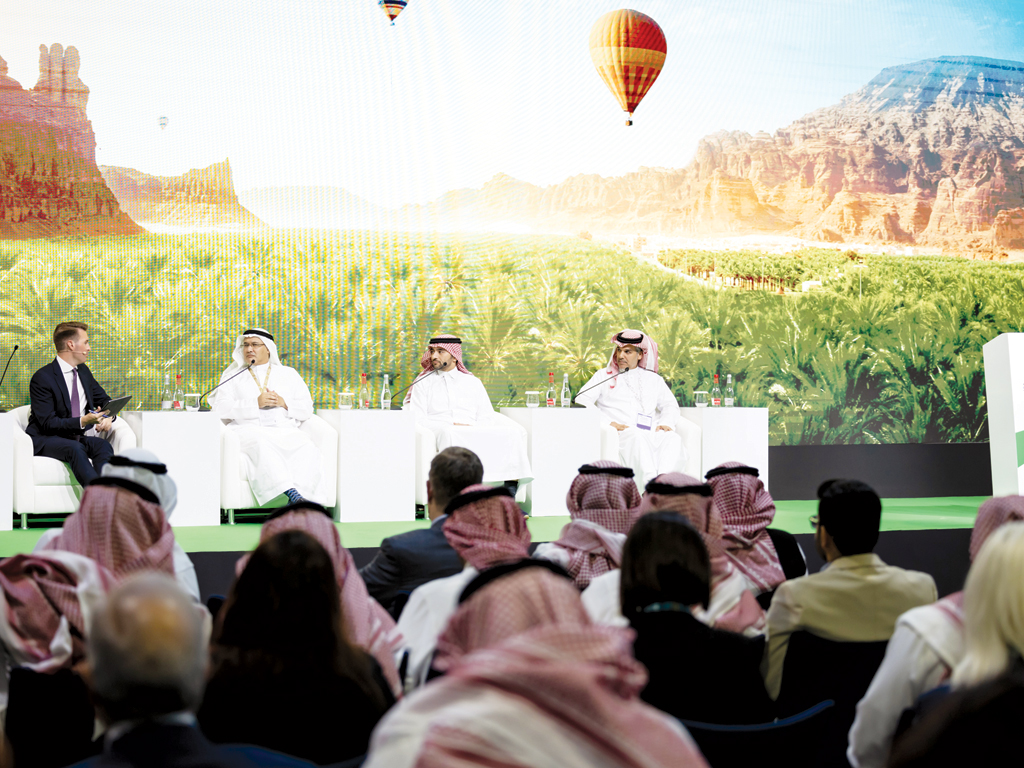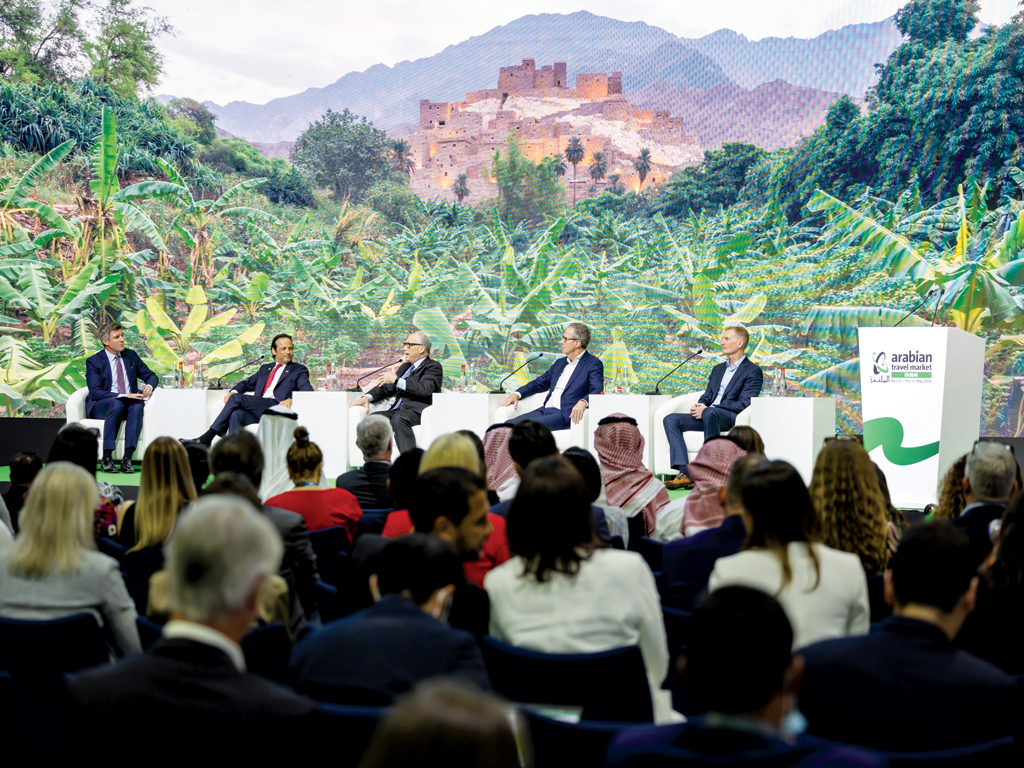Saudi Arabia is looking to avoid mass tourism through carefully considered masterplans and selective partnerships,
according to participants at Arabian Travel Market (ATM) 2022
Staying sustainable


Saudi Arabia plans to avoid over-tourism as it prioritises sustainability and heritage conservation.
The kingdom benefits from a unique position in the world as it hasn’t been exposed to mass tourism; however, most of the ongoing mega-tourism projects are located in regions that contain valuable historical and environmental assets.
John Pagano, CEO of the Red Sea Development Company and Amaala, said that while the Red Sea Project is the largest tourism development in the kingdom, covering 28,000 sq km of pristine lands and waters, the company is only developing a relatively small portion of this area.
“When we conceived the Red Sea Project, we wanted to position the destination in a manner where we work with our ecological ceiling. By that very nature, we’ve decided not to go mass market,” said Pagano.
He explained that the way they were going to control the numbers was by not overdeveloping.
“We have more than 200 km of coastline on the Red Sea project. If you put that anywhere in the world, you can accommodate tens of millions of people. Yet we’re setting ourselves a ceiling of no more than a million, and we’re going to proactively monitor the environment using technology and artificial intelligence,” he said.
SELECTIVE PARTNERSHIPS
With sustainability at the heart of Saudi Arabia’s tourism projects, developers are cautiously choosing the partners and investors they bring in.
According to Pagano, the Red Sea Project is fully capitalised; having raised a $14 billion green loan finance facility in 2021. However, the company is still keen to embrace partnerships and investors to provide a seal of approval from the private sector.
“Because we have financial independence, we can be selective as to who we partner with. When we talk to potential investors, it’s hugely important to us that they share our vision for the environment, and for supporting Saudi Arabia’s ambition to diversify the economy away from oil and build sustainable tourism for its future and population.”
The ancient city of AlUla, which is undergoing a $15 billion transformation that includes a nature conservation plan, is also looking to avoid mass tourism.
Home to a small community of 30,000 people in an area that is sparsely populated, the city is looking to bring in two million of the 100 million annual visitors that the country is targeting by 2030. This will be a big leap from the 146,000 visitors AlUla received in 2021.
“We’re very focused on the luxury and premium market; we’re never going to be a mass-tourism destination. This gives us an advantage in the sense that when we look at partners, we can be very discriminating and selective,” said Phillip Jones, Chief Destination Management and Marketing Officer at the Royal Commission for AlUla.
“For example, we only have five or six certified destination management companies (DMCs) who can sell AlUla product. What we don’t want is a thousand DMCs who don’t know the product they’re selling to the customer base we’re going after. If we’re going to compete on a global stage, we need to make sure we have the quality and experience to be competitive.”
Like AlUla, the historical town of Diriyah is also undergoing a large-scale $50.6 billion transformation, with 38 hotel brands planned for this mixed-use development.
As Diriyah is the ancestral home of the Al Saud family and the location of the UNESCO World Heritage Site of At-Turaif – an iconic mud-brick city – the masterplan has been carefully developed to safeguard the important heritage of this site.
Jerry Inzerillo, CEO of Diriyah Gate Development Authority, said: “We’ve developed concentric masterplans 14 kilometres around the UNESCO World Heritage Site, because Diriyah is culturally sacred. We’re building concentric circles of hotels, restaurants, universities, and residences which will attract people to live, work, recreate, pray, and visit.”
ADVENTURE AND CRUISE TOURISM
With hundreds of miles of untouched landscapes and exciting terrains, developers are also investing in nature- and adventure-based tourism.
The megacity of Neom, for example, is looking to capitalise on its high mountains which receive natural snow in the winter, as well as its vast desert, 450 km of Red Sea coastline, and 39 islands, 12 of which sit above the sea all year-round and are developable.
“One of the fastest growing experiential sectors in the world is adventure travel, which is seeing double digit growth,” said Andrew McEvoy, head of tourism at Neom.
“Saudi Arabia has one of the most challenging environments on earth; we have incredible winds for kite surfing, and high mountains for rock climbing and hiking. We believe that unlocking the explorer in each of us is a highly covetable consumer benefit,” he said.
Cruise tourism is another big focus for Saudi Arabia. Fawaz Farooqui, Managing Director of Cruise Saudi, believes that having the kingdom as part of cruise trips will increase the appeal of itineraries in the Arabian Gulf and the Red Sea.
“Our target is one million passengers [annually] by 2028, which is not hard for us to achieve given all the support we get from the government agencies and our owner, the Public Investment Fund,” said Farooqui.
While cruise vacations have long been considered as an option for seniors, this is changing as young people increasingly go on cruise trips.
Around half of the passengers who have come onboard Cruise Saudi’s ships were below the age of 55, and the company is actively trying to attract a younger demographic by offering shore excursions such as hiking and diving.
Luxury cruises, however, are still attuned to the 50+ market as they are expensive and based on experience rather than activities, according to Farooqui.
“We want to become the largest luxury cruising platform in the world, utilising the niche products we have in Saudi Arabia. We’re a premium destination; we don’t compete on price; we compete on quality and offering,” he said.
MARKETING AS A REGION
Cruise Saudi has already developed ports that are close to three of Saudi Arabia’s six UNESCO World Heritage Sites, including Jeddah’s historical quarter and the ancient city of Hegra in AlUla. It has also signed its first cruise project with Aman; a giga-yacht slated for launch in 2025.
“When it comes to cruise tourism, the pie is big enough. We need to market cruising here as a region. We’ve partnered with Egypt and Jordan to market the Red Sea as a region which will help us attract global cruise lines,” said Farooqui.
“We’re starting to do the same in the Arabian Gulf, where we’re working with Abu Dhabi and Dubai ports to market ourselves as a region. We’re now working on a regional cruising association to take things to the next level,” he said.
Commenting on the dynamics between Saudi Arabia and the UAE, Captain Ibrahim Koshy, CEO of Saudia Air Transport Company, said that the two countries complement each other in tourism and can encourage even more travel to the region.
“When we talk about Saudi Arabia competing; it’s the whole region. Commercial aircraft fleet will have to grow 2.5 to 3 times just to keep up with the demand in the region; the Middle East is growing substantially. I think we’re changing into a regional travel area,” said Koshy.
From an airline perspective, the success of our neighbours is very important to each one of us, be it Qatar Airways, Etihad, or Saudia. Seeing travel grow is a win-win for everybody.”ATM DRAWS 23,000 VISITORS
More than 23,000 visitors attended the 29th edition of Arabian Travel Market (ATM) 2022, as industry leaders gathered at Dubai World Trade Centre (DWTC) to share insights into the future of international travel and tourism.
“In addition to doubling our visitor numbers year-on-year, ATM 2022 hosted 1,500 exhibitors and attendees from 150 countries,” commented Danielle Curtis, Exhibition Director ME for Arabian Travel Market.
“These figures are especially impressive given that lockdowns are still taking place in China and other destinations. What’s more, the development of the travel and tourism sector throughout the Middle East region shows no signs of abating, with GCC hotel construction contract awards set to rise by 16 per cent this year alone.”
With analysis from Colliers International forecasting that $4.5 billion worth of hotel construction contracts will be awarded in the GCC during 2022 “ATM 2022 has provided a timely opportunity for the global travel and tourism sector to gather in Dubai and explore the future of our industry. Innovation, sustainability, technology and talent acquisition and retention will be crucial to its long-term success,” concluded Curtis.
Meanwhile, video-sharing platform ‘Welcome to the World’ secured up to $500,000 of investment after winning the inaugural ATM Draper-Aladdin Startup Competition on the ATM Travel Tech Stage.
Following the success of the hybrid approach adopted for last year’s edition, the live ATM 2022 was followed by ATM Virtual (May 17 and 18).
